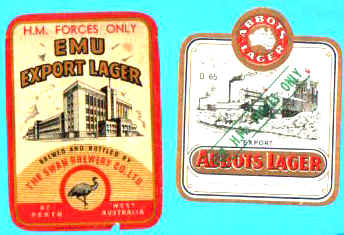 |
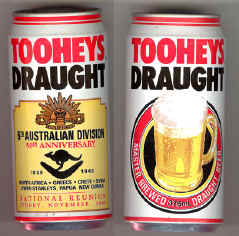
|
| Some beer was produced as
being for "H.M. Forces only" |
Some was produced
for Anniversaries
|
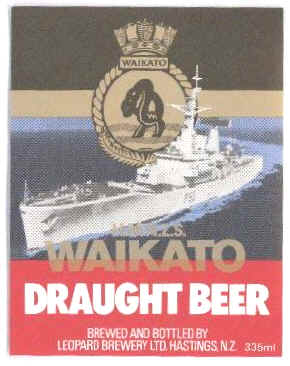 |
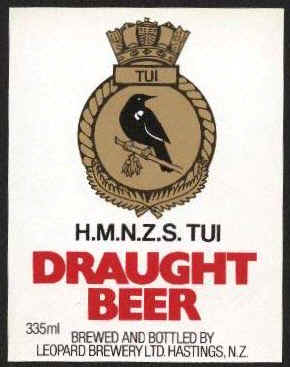 |
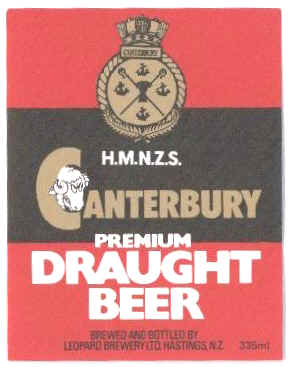 |
- 3 different draught beer
labels of beer made for ships of the New Zealand Navy
|
Origins
From the earliest days of sail, men
have had need of liquid during voyages. The most readily available were
water and beer. As there was no method of distillation, water was taken
on board and stored in casks, to be replaced at the end of the voyage or
at ports of call. Beer was also stored in casks and the ration for
seamen was a gallon a day.
Water would quickly develop algae and turn slimy, and beer would turn
sour. So the custom was to drink the beer before it soured and then turn
to water. Stale water could be sweetened to make it more palatable, and
was often sweetened with beer or wine. As the British Empire grew and
longer voyages became more common, the problem of spoilage and shortages
increased.
The origin of grog lies with
Vice-Admiral William Penn, father of the founder of Pennsylvania, during
his campaign for Cromwell in the Indies. In 1655 Penn arrived in
Barbados and captured Jamaica. Unfortunately Jamaica had few stores of
beer or wine. Jamaica did, however, have rum. Penn, therefore, began the
use of rum as a ration.
In the seventeenth century, an early
form of rum was known as "rumbustion." In Elizabeth 1's time,
privateers and pirates traded in rum, and it was a liquor well-known to
sailors. After 1655, as the Indies became an increasingly popular port,
the use of rum increased. Although it became common, rum was not part of
the "Regulations and Instructions Relating to His Majesty's Service
at Sea" until 1731 at which time a half a pint of rum was made
equal to the provision of a gallon of beer. In the early days this was
specific only to ships in the West Indies, and rum was not diluted.(1)
Vice-Admiral Edward Vernon is known as
the father of grog. Vernon was a noted seaman, and victorious at Porto
Bello, but he was a constant critic of the Admiralty and a supporter of
better conditions aboard ships. He derided pressment and advocated
better treatment of sailors. His sailors gave him the name of "Old
Grog" because of a waterproof boat cloak he wore. (Grogam being a
thick material that was a combination of silk, mohair and wool which was
often stiffened with gum.)
By Vernon's time straight rum was
commonly issued to sailors aboard ship - and drunkenness and lack of
discipline were common problems. On August 21, 1740, Vernon issued an
order that rum would thereafter be mixed with water. A quart of water
was to be mixed with a half-pint of rum on deck and in the presence of
the Lieutenant of the Watch. Sailors were to be given two servings a
day, one between 10 and 12 AM and the other between 4 and 6 PM. To make
it more palatable it was suggested sugar and lime be added. In 1756 the
mixture of water and rum became part of the regulations, and the call to
"Up Spirits" sounded aboard Royal Navy ships for more than two
centuries thereafter.
If the use of grog was common
practice, the mixture was anything but standard. Vernon ordered a
quarter of water to a half a pint of rum (four to one), others ordered
three to one, and Admiral Keith later issued grog at five to one. Seamen
mixed their grog by compass points. Due North was pure rum and due West
water alone. WNW would therefore be one third rum and two thirds water,
NW half and half, etc. If a seaman had two "nor-westers," he'd
had two glasses of half rum and half water.
Rum acquired the nickname
"Nelson's Blood" after Trafalgar (1805). To preserve Lord
Nelson's body, it was placed in a barrel of rum. Legend has it that when
the sailor's learned of this, they drank the rum. From that time on,
grog was also known as "Nelson's
Blood."
Grog did not solve the problem of lack
of discipline. In 1823 the Admiralty conducted an experiment cutting the
daily rum ration in half, to one quarter pint (gill). In compensation
they issued tea and cocoa, increased pay two shillings a month. In 1824
the experiment became permanent with the added bonus of an increased
meat ration. However, as a gill at that time was equal to four double
whiskies today, it was still a very strong mix.
In 1850 the Admiralty's Grog
Committee, which had been appointed to investigate problems associated
with the ration, released a report which confirmed the relationship
between drunkenness and discipline problems, and recommended the ration
be eliminated altogether. As before, they recommended giving seamen
compensation by way of increased pay. However, Effective January 1,
1851, the Admiralty rather than ending the rum ration, merely decreased
it. The rum ration became one half gill, or one eighth of a pint.
Because of the decrease in amount, an effort was made to improve the
quality. Rum brokers experimented with blending and blending formulas
eventually became closely guarded secrets.
Although the American Navy ended the
rum ration on September 1, 1862, the ration continued in the Royal Navy.
However, toward the end of the nineteenth century temperance movements
were beginning to change the attitude toward drink. The days of grog
were slowly coming to an end. Finally, on January 28, 1970 the
"Great Rum Debate" took place in the House of Commons, and
July 30, 1970 was "Black Tot Day," the last pipe of "Up
Spirits" in the Royal Navy. |
|
This
"action" took place due south of Sailly-le-Sec and 3.75km SSW
of le Hamel.
Captain FC
Russell, AIF
Villers
Bretonneux had been captured by the 15th Australian Brigade on
Anzac Day, 1918. The Germans were in there. They'd advanced down
and they were within fifteen kilometers, looking right down on
Amiens, straight down, and that's a fairly big city. Just on
fifteen kilometers,
within gun range. They didn't have any heavy guns to shell it from
there.
They
were firing big long-range guns from further back, lobbing only
occasional big shells in Amiens and doing a bit of damage.
Of necessity, we couldn't tolerate this because while they
could shell Amiens they could interfere with the railway service which
terminated in Amiens. So the 15th Brigade, they divided — half
went to the left, half went to the right — round the back of
Villers Bretonneux, and did it at night, and, and, by Jove! They
met head on.
The
road went straight through Villers Bretonneux and they met on that
road. They had great fun there. One place there was a Winery, and
the Fritzes had found it and it was full of Germans, drunk as
owls. Our fellows got in with them. It finished up with
Australians and Germans drunk
as owls together. Up to their knees in wine in Villers Bretonneux.
Then
the heads said, 'Where's everybody got to?' They suddenly
discovered this Winery and went in, and here was this spectacle.
The Fritzes were dragged out by their feet, drunk as lords, and
they finished up in the prisoners’ compound.
The police had to come and put a guard on this place and
that was the end of that. Then
they mopped up the town. The
line finished just about half a mile beyond Villers Bretonneux.
They never got any further.
The Fritzes never did get Amiens. |
This is how the
Canadians saw it.
Another, more down to earth
morale-booster was the daily rum ration.
Canadian infantryman Ralph Bell wrote
that, "when the days shorten, and the rain never ceases; when the
sky is ever gray, the nights chill, and trenches thigh deep in mud and
water; when the front is altogether a beastly place, in fact, we have
one consolation. It comes in gallon jars, marked simply SRD." That
SRD was army-issued Services Rum Diluted or Special Red Demerara (there
is some difference of opinion on what the letters stood for), and it
became an institutionalized part of the ritual of enduring the war.
Rum and other spirits had long formed
part of the daily issue of the British soldier and sailor on campaign.
During the South African War, where Canadian troops fought under British
command, they received a rum ration consisting of 1/2 gill (less than
half a pint), three times per week. When the 1st Canadian Infantry
Division arrived in France in February 1915, its units were apprenticed
to British veterans already in the line. In the process of learning how
to survive on the Western Front, they were again introduced to the rum
ration.
Rum was used as a combat motivator, a
medicine, and as part of the reward system. An examination of the
multiple uses of rum in battle provides insight into the collective
lives of these soldiers. As a nuanced tool in supporting morale, it
produced results to the point that it was perhaps not surprising that
more than one soldier remarked: "If we hadn't had our rum, we would
have lost the war."
Life in the trenches was nasty and
often short. Summer months were spent in sweltering heat, with rotting
corpses and flies. Winter carried its own trials, with mud and freezing
water saturating the trenches. The squalor broke men down. It was as
unnatural a way to live as having people you have never met attempt to
kill you each day. With their apocalyptic landscapes, battlefields like
the Somme in 1916 and Passchendaele in 1917 were veritable wastelands.
M.A. Searle of the 18th Cdn. Battalion
was one of the infantrymen ordered to hold the dissolving ground at
Passchendaele and he frankly recounted: "Most of us carried
on...because of not limitless but more than ordinary issues of
rum."
Fighting in the same mud, Private G.
Boyd of the 8th Bn. remembered that "if we had not had the rum we
would have died."
Rum was initially given to men at the
dawn stand-to and stand-down at dusk. As these were the expected times
for an enemy attack, the whole forward unit was called out to wait with
rifles at the ready. If no attack came, sergeants doled out two ounces
of the over-proof rum to each man. The practice of stand-to faded out in
the second year of the war when both sides were aware that the other was
on high alert, but the rum ration remained.
Regulations ordered that it was to be
drunk in the presence of an officer or non-commissioned officer so no
hoarding could be done, with any extra rum to be poured out into the
mud. In reality though, not a lot of rum went into the dirt, with
friends of the NCOs and old hands generally benefiting. As one official
memorandum noted, "the individual man is in all cases free to
refuse the issue of rum if he so desires, but this option is only
exercised in a few instances."
If the soldiers found the rum
invaluable, so too did the officers. The issue of rum to soldiers
reinforced the hierarchal nature of the armies that was so integral to
their success. A few lead, many follow. In the unparalleled slaughter of
World War I, discipline and hierarchy were essential. Soldiers rarely
questioned orders, even seemingly suicidal ones. Punishment and
discipline were the main deterrents for potential troublemakers, but rum
also played a role in reinforcing this hierarchy. The clay rum jars were
issued to the battalions, with each quartermaster dividing it out to the
companies. Men who were under punishment were excluded. Those who were
in the good books lined up and the more senior ranking men moved down
the line doling out the precious liquid.
Each soldier waited for his share, all
the while aware that it was the higher-ranking soldier who divided up
the portions, giving a little more or less depending on his whim.
Indeed, the politics of power were essential in all armies and the rum
issue helped to support them.
Rum was also useful as a depressant.
While in the trenches, soldiers were chronically sleep-deprived. One
American who served in the Canadian Corps recounted in a postwar novel:
"Sleep, sleep--if only we could sleep. Our faces become gray. Each
face is a different shade of gray. Some are chalk-colored, some with a
greenish tint, some yellow. But all of us are pallid with fear and
fatigue."
The rum ration helped as a sedative, a
"warming elixir" as one trench soldier described it, and its
potency could knock men out for hours, notwithstanding the cold or heat,
the lice or rats, and the constant pounding of the big guns.
There was a need to continually shore
up defences at night or to protect the front lines by patrolling and
raiding. As a result, extra rum was one of the few rewards for men who
went beyond the call of duty. Patrolling and raiding in no man's land
were dangerous assignments. These raids, normally carried out by parties
of anywhere between a handful and several hundred, were designed to win
control of the battlefield, gather intelligence, provide battle craft
experience, and, obviously, to kill the enemy. Upon carrying out their
raids, survivors were rewarded with a mug of rum.
Other strenuous tasks like carrying
wounded men through miles of mud or repairing crumbling trenches also
made a soldier a candidate for a late-night liquid issue. Particularly
ghastly work like grave digging was among the worst of the soldier's
fatigues. Private Ernest Spillett of the 46th Bn. wrote in a 1917 letter
about having to clear up the corpses from the battalion's last tour:
"I am used to these sights they don't have to prime me with rum
before I can handle a man; although' I have and do certainly drink it
sometimes on those jobs but usually afterwards, to take the taste of
dead men out of my mouth."
After the disastrous campaigns of
1915, the British concluded that the infantry could only pass through
the killing ground of no man's land by advancing behind massive
artillery barrages. Still, the barrages never annihilated all the
defenders, and one machine-gunner was enough to wreak murderous havoc.
With hours and even days of artillery
bombardments "softening" the enemy defences, the worst time on
the front was waiting for zero hour. As minutes ticked down on
synchronized watches, men fiddled with final adjustments, prayed, and
gripped their rifle stocks with sweating hands.
Sergeant Archie McKinnon of the 58th
Bn., wrote to his sister that "after a three-hour artillery
bombardment, when you finally get the word 'Over top in one minute,'
your heart comes clean out of your mouth." Many must have felt as
if they were waiting for their own executions.
"We were all scared...but there
was a job to do and you had to do it. The thing to do was to try and
hide it from the others and not let fellows know you're scared, "
recounted Sergeant James Page of the 42nd Bn. That was not always easy,
but George Bell of the 1st Bn. recorded that "a good stiff 'tot' of
rum served to buck up the spirits of those wavering."
Officers and NCOs went up and down the
forward firing line to calm men with a greeting and a ladle of rum,
beyond the normal ration. Even the generals far from the front realized
the importance of giving artificial stimulants to their warriors.
Operational orders for the Canadian Corps' attack on Vimy Ridge, for
instance, declared that "the comfort, efficiency and fighting value
of the troops are greatly increased by the issue of fortified
alcohol...."
Some operations succeeded while others
failed, but all had terrible casualties. The ebb and flow of battle
meant that soldiers attacked and were, in turn, counter-attacked. The
wounded were left behind as flotsam. During and after battle, those
wounded men who could walk struggled to the rear; but those who could
not, called out in pain or waited as stretcher-bearers braved enemy
fire, administering to them in turn.
When soldiers were found, wounds were
bound and a shot of rum poured down throats
to lessen the pain. Those
who survived the agonizing hours until they made it back to a casualty
clearing station or a field ambulance were once again given painkillers
like rum, port or morphine before a hasty medical operation.
Yet rum had medicinal uses other than
for treating casualties and it was frequently used in a preventive role.
If one is to believe the soldiers, rum helped to quell the rampant flu
and colds that circulated. In addition, rum was valuable in cases of
emotional trauma. One soldier declared in his postwar memoirs:
"There are not one, but numberless occasions, on which a tot of rum
has saved a man from sickness, possibly from a serious illness. Many a
life-long teetotaler has conformed to SRD and taken the first drink of
his life on the battlefields of France, not because he wanted to, but
because he had to."
Fortifying men with alcohol was not
always the best policy, however. Soldiers high on rum could lose their
head on the battlefield and get themselves unnecessarily wounded or
killed. "Under the spell of this all-powerful stuff," wrote
one Canadian, "one almost felt that he could eat a German, dead or
alive, steel helmet and all." For that very reason, rum was
sometimes withheld before battle. Once again, it depended on the
officers and units. That policy did not always sit well with the
expectant soldiers and one draft of rough lumbermen from northern
British Columbia threatened a 54th Bn. officer when he tried to withhold
their rum before battle. They got their rum, and he, as recounted years
later in an interview, learned not to meddle with their ration.
As the issue of rum was left to the
prerogative of commanding officers and medical officers, it placed an
important agent in their hands. If the CO was a teetotaler, then the men
might get lime juice and pea soup instead of rum.
One of the Canadian Corps' most
attack-oriented commanders, or a 'fire-eater' in the parlance of the
time, was Victor Odlum, commanding officer of the 7th Bn. and then the
11th Brigade. With a missionary background, Odlum refused to issue rum
to his troops. Nicknamed "Old Lime Juice" by his men, in the
words of E.L.M. Burns, then a junior officer, but a general in the next
war, his temperance stance "got minus zero in the front-line
opinion polls." Mutinous feelings became so strong that Odlum's
superior officer, General David Watson, had to overrule him and
institute the rum ration in February 1917. In an organization where
soldiers had little power, the withholding of rum was important enough
for them to raise their disenfranchised voices.
The importance of rum in the trenches
was reinforced by its prominence in the cultural expression of the
soldiers. Replete in song and poem, the rum ration was an essential
component of the unique culture that developed in the trenches. Some of
the choice anecdotes in their memoirs and letters revolve around rum. An
examination of their writings, rather than those of the senior officers
or official historians, shows how references to rum slip into so many of
their poems, trench newspapers and memoirs. Even the short-form name of
the rum itself--SRD--was toyed with by the men. They jokingly referred
to it as Seldom Reaches Destination, Sergeants Rarely Deliver, Soldiers'
Real Delight or Soon Runs Dry. Along with the shared language of
soldiers, rum was a component of their more joyous occasions like
singing. One of the few opportunities that soldiers had to express
themselves, their songs consisted of racy lyrics where women, wine and humor
were intermingled.
A favorite, The Old Barbed Wire, has a
stanza that revolves around the sometimes justified suspicion of the
sergeant-major hoarding and cheating the soldiers out of their rum:
If you want to find
the sergeant-major,
I know where he is, I know where he is.
If you want to find the sergeant-major,
I know where he is,
He's boozing up the privates' rum.
I've seen him, I've seen him,
Boozing up the privates' rum,
I've seen him,
Boozing up the privates' rum.
Although all but ignored in
the official military records, rum, as well as the beer canteens,
estaminets, cigarettes, letters and trench newspapers, were essential
items in supporting morale for the overseas soldier. It was these small
comforts that were of prime concern to the individual in the firing line;
grand operational plans mattered far less. As we have seen, rum was a
complex and multi-layered tool. Equally important, rum was the soldiers'
tool and without it, the civilians who made up the soldier's
profession--the bankers, clerks and farmers, who put down their pens and
plows for rifles--might well have collapsed more frequently under the
terrible strain of trench warfare. (http://www.legionmagazine.com/features/militarymatters/02-09.asp#2) |